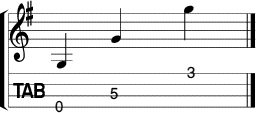|
|
|
Mandolin Tutorials
6) Keys and Scales
|
|
WELL, IF YOU SURVIVED the first lesson, congratulations! The beginning for any instrument is the hardest bit, especially if you've never played anything before. The more you practice and play, the easier it becomes, and in a few weeks you'll be surprised at how much you can do.
Keys
It would be rather dull if every tune was in the same key; indeed when playing a number of tunes together in a set, changes of key can sound very dramatic and lift the music. When we talk about keys in music we're usually talking about what scale is being used. There are two main types of scale used in traditional music, the MAJOR scale and MINOR scale. I'll be talking about minor scales later, but for now we're only concerned with the major. The major scale is exactly the same as the doh-ray-mi-fa-soh-lah-ti-doh scale. If the key of "D" is mentioned, it is actually D major that is being talked about. The scale of D major starts and finishes with the
note D. Try the D scale using the tablature below:

Another Key
You should have noticed a pattern in the D major scale: you used the open, second, fourth and fifth frets on the D string, then the open, second, fourth and fifth frets on the A string. It would be nice and simple if that applied to all the strings and all the scales, but alas, it doesn't. We'll see that when we extend the scales the fingering changes slightly.
However, now that you've mastered the D scale, I want you to play exactly the same fingering but shift the pattern up so that you're starting on the open second string, the A string. You have now mastered a simple scale in A major:

Key of G
You have seen how the D scale and the A scale has used the same fingering, but on a different string. If you used the same fingering on the bottom G string, you would get a scale in G. It would be very nice if it was all this convenient, but unfortunately it's not. Tunes in G rarely fall just between the bottom G string and the fifth fret of the D string. The extended G scale is slightly different. If we start on the fifth fret of the D string (that's a G note) and play a scale upwards, we would use the third fret on the A string. Play the scale below:

IT'S A GOOD IDEA to learn the scales in D, G and A off by heart. This will help you get to know your way around the fretboard, and your fingers will more easily fall into the correct positions.
Octaves
An octave is a gap of eight notes in a scale, equivalent of doh to high do in tonic sol-fa. In the scale of G there are two octaves on the mandolin, as can be seen here:

|